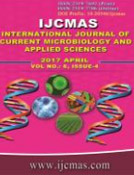


 National Academy of Agricultural Sciences (NAAS)
National Academy of Agricultural Sciences (NAAS)

|
PRINT ISSN : 2319-7692
Online ISSN : 2319-7706 Issues : 12 per year Publisher : Excellent Publishers Email : editorijcmas@gmail.com / submit@ijcmas.com Editor-in-chief: Dr.M.Prakash Index Copernicus ICV 2018: 95.39 NAAS RATING 2020: 5.38 |
Microbiological infection plays vital role in determining the outcome as well as cost and duration of the hospital stay for patients admitted in ICU setup. Of late nosocomial infections especially ventilator associated pneumonias (VAP) have been recognized to be associated with significant morbidity and mortality in intubated patients. It is of critical importance to do regular surveillance of important pathogen (like Methicillin resistant staphylococcus aureus (MRSA), extended spectrum beta lactamase (ESBL) and carbapenemase producers) and its resistance pattern. Culture and sensitivity patterns if properly determined can greatly improve the outcome of critically ill patients being managed in intensive care units. To find out the prevalence of MRSA, ESBL and carbapenemase producing isolates in endotracheal and tracheostomy tube samples of ICU patients and to know its resistance pattern. In this study we aimed to investigate the pattern of microorganism grown and their sensitivity patterns to propose a proper antibiotic treatment in our hospital ICUs. It was a cross sectional observational study which was carried out over a period of 6 months in the department of microbiology at a tertiary care hospital. Approval of ethical committee was obtained before the study. Total 70 samples consisting of endotracheal tubes and tracheostomy tube secretions received in the department of microbiology for culture and sensitivity from patients admitted in two ICUs (SICU, MICU) were processed as per standard microbiological protocol. Pathogens were identified by vitek 2 compact system. MRSA, ESBL and carbapenemase production was detected by vitek 2 system (Biomerieux) antibioticsusceptibility testing of MRSA, ESBL and carbapenemase producers was done. Antibiotics for testing were chosen as per vitek Id cards. The sensitivity patterns of MRSA, ESBL and carbapenamase producers were analyzed. Out of 70 samples 48(68.57%) were culture positive in which 41(87.27%) were monomicrobial and 7 (12.72%) were polymicrobial (2 organisms in 7 samples). Out of 55 isolated organisms 8 were gram positive cocci (14.54%) and Gram negative organisms were 47 (85.46%). Thus total 9 types of organisms were recovered from 48 culture positive samples. Forteen Pseudomonas aeruginosa (25.54%), 14 Acinetobacter baumanni complex (25.54%), 11 Klebsiella pneumoniae. (20%) and 8 Staphylococci (including Staphylocococcus aureus 03 and 05 coagulase negative Staphylococcus (CONS) (14.54%). Followed by 3 E. coli (5.45%), 2 Enterobacter aerogens (3.64%), 1 species each of Serratia marscens, Stenotrophomonas (1.82%). Out of 8 Staphylococcus (S. aureus and CONS) isolates 5 (62.5%) were MRSA and MRCONS. Most of the MRSA isolates were recovered from the endotracheal tube. Out of all isolates of Klebsiella species and E. coli 8 species were ESBL producers (57.14%). The maximum ESBL producing isolates were recovered from MICU and were isolated from endotracheal tubes. Isolated MRSA strains were found to be susceptible to vancomycin, linezolid, teicoplanin and rifampicin amongst tested antibiotics. In isolated ESBL producing organisms the highest susceptibility was noted for colistin and tigecycline. The carbapenemase producing isolates 28(59.57%) showed susceptibility to colistin, amikacin and tigicycline. In present study the prevalence of MRSA, ESBL and carbapenemase producing isolates was 62.5%, 57.14%, 59.57% respectively. MRSA isolates were found to be susceptible to antibiotics like vancomycin, rifampicin, linezolid and teicoplanin while ESBL producing isolates were found to be susceptible to antibiotics like imipenem, colistin and tigicycline. Carbapenemase producing isolates were found to be susceptible to antibiotics like colistin, amikacin and tigicycline. Most of MRSA and carbapenemase producers were from SICU and ESBL from MICU. So we need to strengthen our infection control practices so as to reduce these infections.
 |
 |
 |
 |
 |